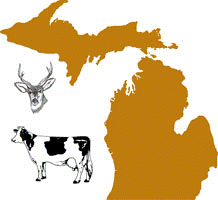Wildlife Disease and Zoonotics
Date of this Version
11-2008
Abstract
Captive and free-ranging wildlife animals are implicated in the maintenance and transmission of bovine tuberculosis and therefore pose a significant obstacle to eradication of the disease from domestic livestock. The current antemortem diagnostic method, the intradermal tuberculin skin test, is impractical for routine use with many wild animals. Antibody-based assays are particularly attractive because the animals are handled only once and immediate processing of the sample is not required. This report characterizes the antibody responses of red deer-elk hybrids (Cervus elaphus) against Mycobacterium bovis and subsequently evaluates the diagnostic performance of select antigens in a rapid-test format. Sequential serum samples were collected from 10 animals experimentally infected with M. bovis and 5 noninfected animals over a 7-month period postinfection (p.i.). Samples were evaluated by enzyme-linked immunosorbent assays, immunoblot analyses, and multiantigen print immunoassays for seroreactivity to mycobacterial antigens. Although all infected animals produced antibodies to M. bovis protein antigens, there was significant animal-to-animal variation in the kinetics and magnitudes of responses and the antigens recognized. The most frequently recognized antigens included MPB83, ESAT-6, CFP10, and MPB70. Responses to some antigens, such as MPB83, were consistently detected as early as 4 weeks after inoculation, whereas other antigens were detected only much later (>140 days p.i.). Antibody responses were boosted by injection of tuberculin for intradermal tuberculin skin testing. Comparison of single-antigen (fluorescence polarization assay) with multiantigen (CervidTB STAT-PAK) rapid tests demonstrated that a highly sensitive and specific serodiagnostic test for tuberculosis in cervids will require multiple and carefully selected seroreactive antigens covering a broad spectrum of antibody specificities.



Comments
Published in CLINICAL AND VACCINE IMMUNOLOGY, Nov. 2008, p. 1650–1658.